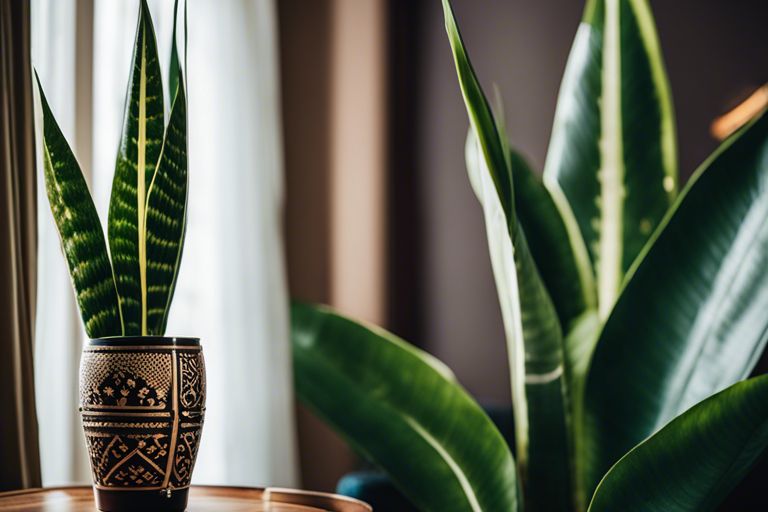Superstitions surrounding plants and their impact on luck have been prevalent across various cultures for centuries. One such belief that has persisted is the idea that snake plants bring bad luck to a home. But why? In this article, we probe into the origins of this superstition and explore the cultural beliefs that have contributed to the misconception surrounding these popular houseplants.

Key Takeaways:
- It’s tied to cultural beliefs: The superstition surrounding snake plants being bad luck originates from cultural beliefs in some regions of the world.
- Shape and name associations: The snake-like appearance of the plant and its name may contribute to the belief that it brings negative energy or bad luck into the household.
- Not universal: While some cultures view snake plants negatively, others consider them symbols of good fortune, prosperity, and health.

The Origin of Superstitions
One of the most intriguing aspects of superstitions is their origin. Superstitions are often rooted in cultural beliefs, historical events, and even psychological tendencies. These deeply ingrained beliefs have been passed down through generations, shaping the way people perceive certain objects or symbols.
Understanding Superstitions
One common explanation for superstitions is the need for control. In uncertain or dangerous situations, humans tend to seek out patterns and create rituals to feel a sense of control over their environment. Superstitions provide a way to make sense of the unknown and offer a semblance of security in an unpredictable world.
Historical Perspectives on Plant-Related Superstitions
Superstitions surrounding plants have a long history, often intertwined with folklore and traditions. In some cultures, certain plants were believed to possess mystical powers or be connected to supernatural forces. People developed superstitions around plants to either ward off evil spirits or attract good luck and fortune. These beliefs reflected the importance of plants in daily life and the spiritual significance attributed to them.
Superstitions have played a significant role in shaping human behavior and society throughout history. While some may dismiss them as irrational beliefs, it is vital to acknowledge the cultural significance and the impact they have on individuals and communities. Understanding the psychological motivations behind superstitions can provide insights into human nature and the complexities of belief systems.
Snake Plants: Botanical Overview
After delving into the world of superstitions and cultural beliefs surrounding snake plants, it’s important to take a closer look at the plant itself. Understanding its scientific classification, growth patterns, and characteristics can provide valuable insights into why this plant has garnered such a reputation.
Scientific Classification
With its scientific name Sansevieria trifasciata, the snake plant belongs to the Asparagaceae family. This evergreen perennial herb is native to West Africa and thrives in a variety of conditions, making it a popular choice for indoor cultivation. Known for its striking sword-shaped leaves and air-purifying abilities, this plant has become a staple in many households around the world.
Growth and Characteristics
Plants of the Sansevieria genus are recognized for their low maintenance and drought-tolerant nature, making them ideal for novice plant owners. The snake plant’s striking foliage comes in various patterns and colors, adding a touch of elegance, whether placed in a modern minimalist setting or a bohemian jungle vibe. Additionally, their ability to thrive in low light makes them the perfect choice for offices or rooms with minimal sunlight.
To further enhance the growth and characteristics of snake plants, ensure they are planted in well-draining soil and watered sparingly, as overwatering can lead to root rot. These resilient plants can withstand neglect and continue to purify the air by removing toxins such as formaldehyde and benzene, making them a valuable addition to any living space.
Cultural Significance of Snake Plants
Positive Symbolism
To many cultures around the world, snake plants hold positive symbolism and are believed to bring good fortune and prosperity to households. In Chinese culture, snake plants are associated with wealth and prosperity due to their resemblance to the mythical creature ‘dragon,’ which symbolizes strength, resilience, and good luck. In African folklore, snake plants are considered protective plants that ward off evil spirits and negative energy, bringing harmony and purity to the home.
Negative Symbolism and Associations with Bad Luck
Snake plants have also been associated with negative symbolism and beliefs in some cultures, leading to the superstition that they bring bad luck. In Feng Shui, the pointed leaves of snake plants are believed to bring negative energy and discord into the home, disrupting the flow of positive chi. In some parts of Europe, snake plants are thought to carry a malevolent energy and are avoided in homes due to their alleged connection to deceit and treachery.
For instance, in some Eastern European cultures, snake plants were believed to attract illness and misfortune if kept indoors. Despite their air-purifying abilities, these plants were avoided in homes out of fear of bringing sickness and death to the inhabitants. While these beliefs may seem unfounded to some, they have contributed to the superstition surrounding snake plants in certain regions.
Perspectives Around the World
African Cultural Beliefs
On the African continent, snake plants, also known as mother-in-law’s tongue, are believed to bring luck and protection to the household. In many African cultures, these plants are associated with resilience and strength, making them a popular choice for homes. The long, pointed leaves of the snake plant are thought to symbolize sharpness that wards off negative energy and evil spirits.
Asian Folklore and Traditions
The snake plant holds different meanings in various Asian countries. In Chinese culture, the snake plant is believed to bring financial prosperity and good luck. Its vibrant green leaves are said to attract positive energy and wealth into the home. In Japan, the snake plant is associated with longevity and health, making it a popular choice for gifts to wish for a long and healthy life.
The snake plant is also deeply rooted in Indian traditions, where it is considered to bring good fortune and prosperity to the household. In Feng Shui, the snake plant is believed to bring positive energy and balance to the space, making it a favored plant for enhancing the flow of Chi.
Western Views and Modern Beliefs
Traditions around the snake plant in the Western world vary. While some view it as a symbol of resilience and protection, others associate it with negative superstitions. In Victorian times, the snake plant was seen as a sinister plant, believed to bring disease and death to those who kept it in their homes. However, in modern times, the snake plant has gained popularity for its air-purifying properties and low maintenance requirements, making it a trendy choice for indoor plants.
To understand the diverse perspectives surrounding snake plants, it is important to consider the cultural context and historical beliefs associated with the plant. While superstitions may vary, the snake plant continues to be a popular choice for households around the world, valued for its aesthetic appeal and purported positive qualities.

The Psychology Behind Plant Superstitions
Once again, let’s research into the fascinating world of superstitions surrounding plants, particularly snake plants. The beliefs surrounding snake plants being bad luck stem from deep-rooted cultural superstitions and psychological biases that have been passed down through generations.
Cognitive Biases and Superstitious Beliefs
To understand why some people believe snake plants bring bad luck, we need to look at cognitive biases that influence superstitious beliefs. One common bias is the confirmation bias, where individuals seek out information that confirms their existing beliefs. If someone believes that snake plants bring bad luck, they may be more likely to notice negative events that occur in the presence of the plant and attribute them to its presence.
The Impact of Superstitions on Human Behavior
Biases in perception and belief can have a significant impact on human behavior. Believing that a snake plant brings bad luck may lead to unnecessary fear or anxiety in individuals who hold this belief. This can result in them avoiding snake plants or feeling distressed in their presence, affecting their well-being and quality of life. It’s vital to recognize the influence of superstitions on behavior and challenge irrational beliefs through rational thinking and education.
Rationalizing the Superstitions
Now, let’s investigate into the rational explanations behind the superstitions surrounding snake plants. While these beliefs may seem rooted in mystery and folklore, there are scientific and logical reasons that can help us understand the origins of these misconceptions.
Scientific Explanations for Misconceptions
On a scientific level, some myths surrounding snake plants can be attributed to their unique ability to thrive in low-light conditions and survive with minimal water. This hardiness can lead to the misconception that they are unfeeling or even sinister entities. Additionally, the sharp shape and pointed leaves of snake plants may have contributed to beliefs that they possess negative energy or bring bad luck.
Debunking Myths: The Truth About Snake Plants
Debunking misconceptions about snake plants is crucial to appreciating these versatile and beneficial houseplants. Despite the superstitions attached to them, snake plants are excellent air purifiers, effectively removing toxins such as formaldehyde and benzene from indoor environments. Their ability to thrive with little maintenance makes them a popular choice for busy households or individuals with limited gardening experience.
Understanding the truth about snake plants can help dispel the myths and superstitions that have surrounded them for centuries. By embracing the positive qualities of these plants, we can appreciate them for their beauty and health benefits, rather than fear them for unfounded reasons.
Living with Snake Plants: Anecdotes and Experiences
Not all tales surrounding snake plants are filled with superstition and fear. Many individuals have shared their personal experiences of living with these unique plants, showcasing a range of outcomes that debunk the notion of bad luck.
Personal Tales of Luck and Misfortune
Anecdotes from snake plant owners offer a glimpse into the varied experiences people have had with these plants. While some may attribute positive changes in their lives to the presence of a snake plant, others have encountered challenges that they connect to the plant’s energy. It’s fascinating to note how personal beliefs and experiences shape these interpretations.
Gardening with Snake Plants: Tips and Advice
Misfortune may visit even the most careful gardeners, but understanding the needs of snake plants can help mitigate risks and ensure successful growth. Choosing the right soil, providing adequate sunlight, and watering sparingly are vital factors in cultivating a thriving snake plant. This sturdy plant can withstand neglect better than most, but regular care will guarantee its longevity. Ensuring proper drainage and occasional fertilization will contribute to the overall health of the plant.
Personal experiences with snake plants can vary greatly depending on the care and attention given to them. While they are known for their air-purifying properties and low maintenance, overwatering can lead to root rot and other issues. By following a few simple guidelines, you can enjoy the benefits of having a snake plant in your home or garden for years to come.
Conclusion
Now, after investigating the superstitions and cultural beliefs surrounding snake plants, it is evident that they are considered bad luck in some cultures due to their resemblance to snakes and association with death. These superstitions have been passed down through generations and play a significant role in how snake plants are perceived. However, it is important to remember that these beliefs are rooted in folklore and should not be taken as facts.
Despite the negative connotations attached to snake plants in certain cultures, it is important to recognize that plants, in general, bring life and greenery into our homes, providing numerous benefits such as improving air quality and reducing stress. Instead of focusing on superstitions, we should appreciate the beauty and benefits that plants like snake plants offer, enhancing our living spaces with their unique shapes and patterns.
